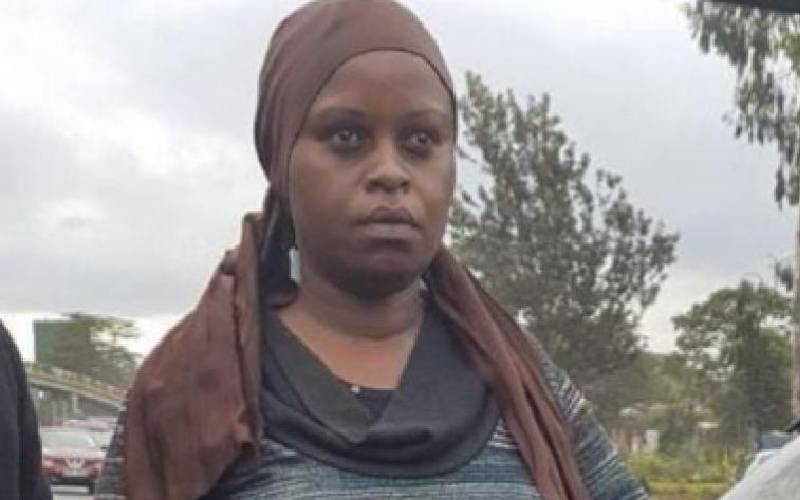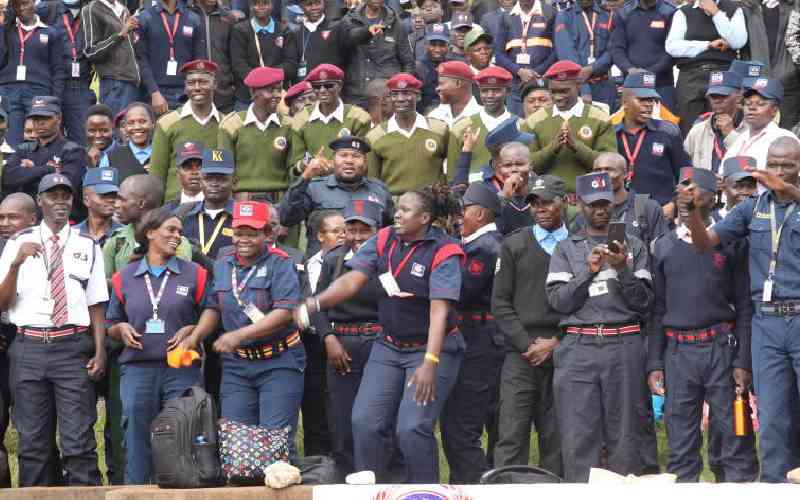They use all manner of tricks and disguises to beat detection, but in the event they are no match to the technology and prying eyes of officers, they revert to intimidation and brute force, including contract killings to have their way, writes DANN OKOTH.
Disturbing details have emerged on how drug lords meticulously plan and execute narcotics shipment into the country.
A secret dossier in the possession of The Underworld on drug trafficking also reveals how the ingenious operations are also fraught with danger as the ruthless drug lords would not hesitate to kill anybody standing in their way. |
Police Commissioner Mathew Iteere and other senior police officers inspect a drug haul netted at the Coast recently as the suspects watch. [PHOTO/ COLLINS KWEYU/STANDARD] |
According to the document marked “Secret/Rel, Kenya” and believed to originate from American intelligence sources, containers carrying drugs arriving at the port are variously disguised as those carrying powdered milk, rice, ballpoint pens and dry cells. However, in reality they are laden with narcotics.
Other times the containers are redesigned to create a fake bottom with drugs being hidden between the fake and the real bottom.
Murky trade
The syndicates have infiltrated the Government with the law enforcement agencies being involved in the murky trade. Rogue police officers, armed forces personnel and even State House officials have been drafted to work for the cartels.
The drugs rings also secretly control Kenya’s freight system including owning and commanding huge shares in some major freight companies. They have influence over the entire depots network in the country and are deeply entrenched at Kenya Revenue Authority.
They use all manner of tricks and disguises to beat detection at the ports of entry, but in the event they are no match for the technology and prying eyes of officers they revert to intimidation and brute force, including contract killings to have their way.
But it is the level of official complicity in aiding, abetting and facilitating drugs permeation in the country that is more shocking.
The dossier shows how the country expressed a high level of frustration with the poor handling of investigation and prosecution by the Kenya Police and the department of public prosecutions of people suspected of trafficking the 1,141.5kg cocaine seized in 2004 in both Malindi and Nairobi.
There was a tug of war between the courts and police over production of the drugs before the court, although technically the drugs were under the court’s jurisdiction once the case commenced. One of the only three police officers said to have keys to the storage facility was murdered early last year under highly suspicious circumstances.
Several of his immediate family members were also killed, sending a chilling message to all those who were positively involved in the case. To show how the kingpins pull strings, the dossier shows how on a sultry afternoon in October at Mombasa’s Kilindi Port a middle-aged man in a dark grey suit arrives at the port to conduct business. The man known only as Paulo, who is also known to be a close associate of a powerful politician in the Government, is a suave operator and owns several clearing and forwarding firms and transport companies.
Earlier that day a suspicious shipment arrived in a container from a Port in Oman. The shipment allegedly contained 100 cartons of canvas shoes. It was later to be cleared by Paulo.
On the same day, Paulo was also involved with a shipment of a suspicious container whose manifests indicated it held ceramic tiles, aluminum doors and locks, candles and additional unspecified merchandise.
In the same month, Paulo imported two containers of used clothing to Mombasa. One container was released but the second was stopped by a customs officer at a container freight station. Paulo paid a bribe of Sh1 million to have the customs officer replaced.
In September 2008, Paulo and a man close to State House operatives and who is also believed to own a chain of clearing and forwarding companies cleared seven suspicious containers from the port.
Stay informed. Subscribe to our newsletter
Paulo had earlier held a lengthy discussion with the ship captain that had brought in the goods the night it arrived. He insisted that the shipment avoid being X-Rayed, as is the clearance procedure. At this point, an associate named B, who has connection with NSIS, came in to assist.
These particular containers may have had ties with Afghanistan due to contact numbers in that country associated with the imports.
Paulo is also a close associate of a man known only as Mo, who is his trafficking partner. Mo is associated with many senior political officials in the Government and police officers who are aware of his trafficking activities and benefit financially from his drugs business. He owns a popular nightclub in Nairobi, which is frequented by influential political figures. In 2008 he received several containers of narcotics, according to the report, from Pakistan, Dubai and Tanzania, which he stored at different distribution sites in Gikomba, Mathare and Githurai in Nairobi.
He is in close associate of a woman who uses beggars and street children in the Central Business District to sell the drugs.
Mo also owns a fleet of matatus whose drivers and conductors are used to distribute the drugs.
He previously used a location near a military base in Nairobi as a processing and packaging facility. He is allegedly associated with an unidentified senior military officer who protected narcotic trafficking activities at the military facility.
Covering tracks
“In late 2008, heroine was brought into the base by body cavity couriers and was cut with chemicals, packaged using special machinery and shipped out of the base in military vehicles to distribution sites,” the report reveals.
To cover their tracks, the cartels have enlisted the services of the police and the Judiciary who are now at their beck and call.
Mo, for instance, is linked to senior officers at CID headquarters and several policemen at Shauri Moyo police station. The officers regularly contact Mo regarding arrested members of his cartel. He influences and coordinates timing and movement of prisoners for court appearances with particular police officers in tow.
In late July 2008, for instance, Mo engineered the arrest of CID officers on charges of abusing one of his female associates. The officers faced fines and dismissal from the force.
 The Standard Group Plc is a
multi-media organization with investments in media platforms spanning newspaper
print operations, television, radio broadcasting, digital and online services. The
Standard Group is recognized as a leading multi-media house in Kenya with a key
influence in matters of national and international interest.
The Standard Group Plc is a
multi-media organization with investments in media platforms spanning newspaper
print operations, television, radio broadcasting, digital and online services. The
Standard Group is recognized as a leading multi-media house in Kenya with a key
influence in matters of national and international interest.
 The Standard Group Plc is a
multi-media organization with investments in media platforms spanning newspaper
print operations, television, radio broadcasting, digital and online services. The
Standard Group is recognized as a leading multi-media house in Kenya with a key
influence in matters of national and international interest.
The Standard Group Plc is a
multi-media organization with investments in media platforms spanning newspaper
print operations, television, radio broadcasting, digital and online services. The
Standard Group is recognized as a leading multi-media house in Kenya with a key
influence in matters of national and international interest.








